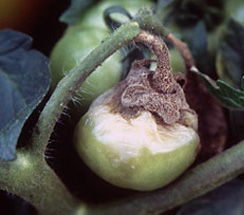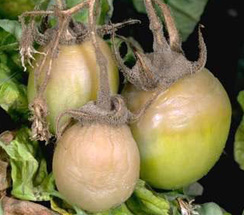| Gray Mold: Botrytis cinerea |
Symptom:
- Lesion - a watery area with a light brown or tan-colored central region.
- Converted into a soft, watery mass within a few days.
- Skin is broken, the grayish mycelium and spore clusters develop within a few hours.
- Halo forms around the point of entry -small whitish rings approximately - develop on young green fruit.
- "ghost spots" are usually single rings but may be solid white spots;the center of which contain dark-brown specks.
|
 |
 |
 |
 |
| Tan-colored central region |
Mycelium |
Soft watery mass |
Rotten tomato |
|
Identification of pathogen:
- Greek botrys, meaning a bunch of grapes
- One-celled spores are borne on branched conidiophores
- Sclerotia -measure up to 3 mm - smaller & thinner
- Germinate to produce conidiophores or, rarely, give rise to small cup-shaped structures (apothecia)
Favourable condition:
- Optimum RH for spore production is about 90%
- Spores are produced during the night when the temperature is lower and the RH is higher than during the day.
- Ideal Temperatures of 17–23 °C
- The length of the surface wetness period needs to be longer at the lower temperatures for disease development
Spread and survival:
- Botrytis produces sclerotia which survive in soil, dead plant material, or on different host plants
- Easily disperse large distances by wind & shorter distances by splashing and windblown rain
- Fruit can be infected through the stem scar, growth cracks, or other breaks in the skin
- Plants approaching maturity are more susceptible
|
Management:
- Ensure good drainage facility
- In the greenhouse, maintain a RH of less than 80%, during the night
- Remove decaying plant material from the plant bed
- Avoid bruising during packing and transport
- Pre harvest spray 0.2% captan at monthly intervals
|
Content validator:
Dr. M. Deivamani, Assistant Professor, Horticulture Research Station, Yercaud-636602.
Source of Images:
http://vegetablemdonline.ppath.cornell.edu/PhotoPages/Tomatoes/Tom_Botrytis/Tom_BotrytisFS2.htm
http://vegetablemdonline.ppath.cornell.edu/DiagnosticKeys/TomFrt/Gray_Tom.htm
http://vegetablemdonline.ppath.cornell.edu/PhotoPages/Tomatoes/Tom_Botrytis/Tom_BotrytisFS3.htm
http://www.ipm.ucdavis.edu/PMG/r783103211.html |




